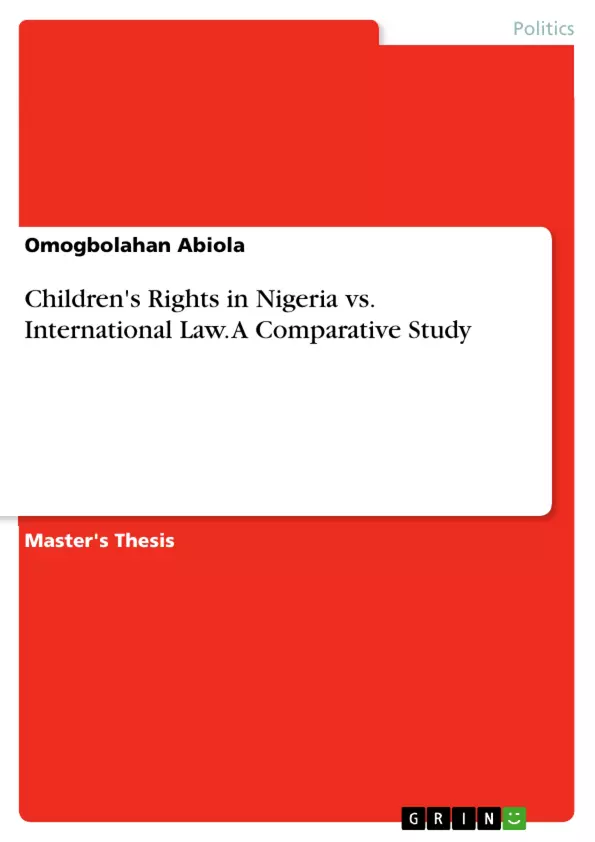This comparative study examines the status and implementation of children's rights in Africa, with a specific focus on Nigeria, in comparison to IHRL. By analysing relevant statutes, judicial decisions, and secondary sources, this research aims to explore the similarities and differences in the legal frameworks governing child rights in these two contexts. The dissertation investigates the extent to which Nigeria aligns with international human rights standards and identifies the challenges and opportunities in promoting and protecting children's rights. Through this analysis, the study contributes to a better understanding of the gaps in children's rights implementation in Nigeria and provides recommendations for enhancing the legal and practical frameworks for the protection of children's rights.
Inhaltsverzeichnis (Table of Contents)
- Chapter 1 Introduction
- Chapter 2 Child Sexual Abuse
- Chapter 3 Child Marriage
- Chapter 4 Child Labour
- Chapter 5 Conclusion
Zielsetzung und Themenschwerpunkte (Objectives and Key Themes)
This dissertation aims to comparatively analyze the status and implementation of child rights in Nigeria against the backdrop of International Human Rights Law (IHRL). It seeks to identify similarities and differences in the legal frameworks, assess Nigeria's alignment with international standards, and highlight challenges and opportunities in protecting children's rights. The research utilizes statutes, judicial decisions, and secondary sources to achieve its objectives.
- Comparative analysis of Nigerian child rights legislation and IHRL
- Assessment of Nigeria's compliance with international child rights standards
- Examination of challenges and opportunities in child rights implementation in Nigeria
- Identification of gaps in the legal and practical frameworks for protecting children's rights
- Recommendations for enhancing child rights protection in Nigeria
Zusammenfassung der Kapitel (Chapter Summaries)
Chapter 1 Introduction: This introductory chapter sets the stage for the comparative study by outlining the research problem, its significance, and the methodology employed. It provides background information on child rights within the context of IHRL and introduces the specific focus on Nigeria. The chapter lays out the scope of the research, defining key concepts and establishing the framework for the subsequent chapters' analyses.
Chapter 2 Child Sexual Abuse: This chapter delves into the pervasive issue of child sexual abuse in Nigeria, analyzing its prevalence, legal frameworks addressing it, and the challenges in enforcement. It likely compares and contrasts Nigerian legislation and practices with international standards set by IHRL, potentially examining specific legal cases and exploring societal factors contributing to this problem. The chapter will highlight disparities between legal protections and practical realities for child victims in Nigeria.
Chapter 3 Child Marriage: This chapter focuses on the practice of child marriage in Nigeria, a significant human rights violation. It will examine the legal landscape surrounding child marriage, including relevant statutes and judicial interpretations, and compare these with IHRL provisions prohibiting such practices. The chapter likely discusses cultural and social factors that perpetuate child marriage, explores the consequences for affected children, and analyzes the effectiveness of existing legal measures to combat this issue. It will probably include a discussion of the challenges in enforcing laws against child marriage.
Chapter 4 Child Labour: This chapter addresses the problem of child labour in Nigeria, examining its various forms, prevalence, and the existing legal and policy responses. The analysis likely includes a comparison of Nigerian laws and their implementation with international standards on child labour as defined by IHRL. This would likely involve exploring the effectiveness of existing regulations, highlighting loopholes and shortcomings, and discussing the societal and economic factors that contribute to child labour. The chapter will probably suggest ways to improve the protection of children from exploitation through labour.
Schlüsselwörter (Keywords)
Child rights, Nigeria, International Human Rights Law (IHRL), child sexual abuse, child marriage, child labour, legal frameworks, implementation challenges, comparative analysis, human rights violations, legal protection, societal factors.
Frequently asked questions about the Language Preview
What is this Language Preview about?
This Language Preview provides an overview of a dissertation that comparatively analyzes the status and implementation of child rights in Nigeria against the backdrop of International Human Rights Law (IHRL). It includes the table of contents, objectives, key themes, chapter summaries, and keywords.
What are the main topics covered in the dissertation?
The dissertation focuses on key child rights issues in Nigeria, including child sexual abuse, child marriage, and child labour. It also addresses the legal frameworks and implementation challenges related to these issues.
What are the objectives of the dissertation?
The dissertation aims to: comparatively analyze Nigerian child rights legislation and IHRL; assess Nigeria's compliance with international child rights standards; examine challenges and opportunities in child rights implementation in Nigeria; identify gaps in the legal and practical frameworks; and provide recommendations for enhancing child rights protection in Nigeria.
What does Chapter 1 cover?
Chapter 1 is an introduction that sets the stage for the study by outlining the research problem, its significance, and methodology. It provides background information on child rights within the context of IHRL and introduces the specific focus on Nigeria.
What does Chapter 2 cover?
Chapter 2 examines child sexual abuse in Nigeria, analyzing its prevalence, legal frameworks, and enforcement challenges. It compares Nigerian legislation and practices with international standards.
What does Chapter 3 cover?
Chapter 3 focuses on child marriage in Nigeria, examining the legal landscape, relevant statutes, and judicial interpretations, and comparing these with IHRL provisions.
What does Chapter 4 cover?
Chapter 4 addresses child labour in Nigeria, examining its various forms, prevalence, and the existing legal and policy responses. It includes a comparison of Nigerian laws and their implementation with international standards on child labour.
What are the keywords associated with this dissertation?
The keywords are: Child rights, Nigeria, International Human Rights Law (IHRL), child sexual abuse, child marriage, child labour, legal frameworks, implementation challenges, comparative analysis, human rights violations, legal protection, societal factors.
- Citation du texte
- Omogbolahan Abiola (Auteur), 2023, Children's Rights in Nigeria vs. International Law. A Comparative Study, Munich, GRIN Verlag, https://www.grin.com/document/1552940



